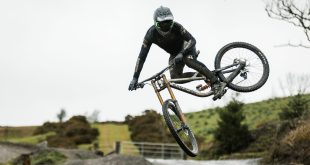The transaction is structured as a merger of RockShox with a wholly-owned subsidiary of SRAM Corporation, in which stockholders of RockShox will receive the cash amount of $0.41 per share.
Paul Turner, founder of Rockshox and still the largest individual shareholder, said that that even notoriously underfunded Singletrack magazine could have bought the once great RockShox for the deal on offer.
In an interview printed in the Denver Post in September last year Turner was scathing of the ‘suits’ brought in to run bike companies:
"Professional management types come in and they just can’t understand the ‘pixie dust’."
Turner, who left RockShox to found MTB maker Maverick American, was in the UK for the 34th birthday party of Singletrack editor Chipps Chippendale.
"As he was tucking into his chicken Jalfrezi in the SuHag Curry House in Rochdale, Paul got a call, via my mobile phone, from a RockShox employee telling him to expect a call from the US in a short while," Chippendale told Bikebiz.co.uk.
"When the call came, Paul retreated into the loo because the Indian music was too loud to
hear the financial deal being offered."
Turner, a Honda motocross race mechanic, founded RockShox in 1989 as a true garage brand. He had shown his first forks at Interbike in 1987, where the design was poo-poohed.
Should US regulatory authorities allow the SRAM/RockShox deal to go ahead – which is likely – the transaction will be completed by the end of March.
Bryan Kelln, RockShox president and CEO said: "The leadership team of RockShox has been very focused over the past two years to restructure the company. We have made many changes which have produced a reduced cost structure, a strong product line, and wonderful customer relationships. However, the costs associated with the restructuring, combined with the costs associated with our patent defence litigation and a product recall last year, have left us in a difficult liquidity position. [And] industry-wide sales declines over the past year hampered our ability to generate revenue."
Q4 sales for RockShox were down by 13.8 percent to $17.5m. OE sales decreased 26.9 percent and after-market sales decreased 15.3 percent in a nine-month period ending 31st December 2001.
Stan Day, president and CEO of SRAM Corporation said: "We are delighted to have the opportunity to put together two of the strongest brands in the bicycle industry. We have been interested in diversifying our core business into suspension, and the RockShox opportunity fits perfectly with that strategy. The SRAM/RockShox combined entity will enable synergies across the businesses – from sales and marketing benefits to our Original Equipment and Aftermarket customer base, to enhanced and integrated product development for the riding enthusiast. Together, our global strength will enable us to have an even more meaningful presence in the industry, at events, and with the consumer.
"The integration of RockShox’ full line suspension within SRAM’s core product groups will contribute significantly toward SRAM’s mission of being the most valuable supplier to the industry.
"We believe that out new larger organisation, with full product lines in drivetrain, suspension and brakes will better serve our customers.
"The timing is perfect as issues of supply chain management are a top priority to bike factories and aftermarket distributors globally."
A press release from SRAM said an integration plan would be completed by June but that some details would be released before that at the Taipei Show, 11-14th April.
ROCKSHOX SEC FILING:
[RockShox Inc] believes that, due to continued losses in the first nine months (and especially the third quarter) of fiscal 2002, and with limited ability to predict its fourth quarter sales, it will require approximately an additional $2.0 million in cash to satisfy short term working capital needs. Following any such cash infusion, the Company’s ability to continue as a going concern will be dependent upon its ability to generate sufficient cash flow to fund working capital and to ultimately sustain profitability. The Company incurred a net loss of approximately $6.1 million for the year ended March 31, 2001, and $7.1 million for the three quarters ended December 31, 2001….
As a result of its significant liquidity issues, the Company is actively pursuing a purchaser of the Company’s assets or stock. In-depth discussions have been ongoing with two potential purchasers, each of whom is proposing a cash-out merger of the Company to become a wholly-owned subsidiary of such purchaser…
Effective February 11, 2002, we entered into a Settlement and License Agreement with Answer Products, Inc., which settled Answer Product’s lawsuit against the Company. According to the terms of the settlement, RockShox receives fully paid licenses to use the patents that remained at issue in the suit. RockShox has agreed to pay Answer the amount of $750,000 on or prior to June 30, 2002 (or earlier in certain change of control and other cases), or, at the Company’s option, the amount of $250,000 for each of four consecutive annual payments on June 30, 2002, 2003, 2004 and 2005. We have accrued $750,000 in Other Accrued Liabilites in the Condensed Consolidated Balance Sheet as of December 31, 2001….
Net sales. Net sales for the quarter ended December 31, 2001 was $17.5 million, a decrease of 13.8% from $20.3 million for the corresponding period of the prior year. For the nine months ended December 31, 2001, net sales decreased by 24.5% to $42.3 million, from $56.0 million for the corresponding period of the prior year. For the quarter ended December 31, 2001, OEM sales decreased by 12.0% to $13.8 million compared to $15.7 million in the corresponding period of the prior year, and decreased by 26.9% to $31.8 million from $43.6 million for the related nine months of operations. Sales to the retail accessory market in the quarter ended December 31, 2001 were $3.7 million compared to $4.6 million in the corresponding period of the prior year, a decrease of 19.6%. For the nine months ended December 31, 2001, sales to the retail accessory market decreased by $1.9 million, or 15.3%, to $10.5 million compared to $12.4 million in the corresponding period of the prior year. The OEM sales decrease resulted from continuing soft demand worldwide for mountain bike components, caused primarily by excess inventory throughout Europe, unfavorable weather conditions in the first quarter and financial challenges faced by certain US customers. Sales for the retail accessory market are down for the nine months ended December 31, 2001 because in the first quarter we relocated the manufacturing portion of our operations to Colorado Springs, and made the decision to discontinue 2001 model year production in conjunction with our move. As a result, we had less 2001 inventory to pass on to the after-market channel than is typical of our first fiscal quarter ($3.2 million in after-market sales through June 30, 2000 as opposed to $1.6 million through June 30, 2001). …
Since 1999, we have experienced recurring losses and have been unable to generate sufficient working capital needed to meet our cash needs. Beginning in 2000, we began restructuring our organization to reduce our expenditures on infrastructure, including rent, salaries and other manufacturing expenses, which included relocating the business to Colorado Springs, a more economically favorable environment. As we relocated our selling, administrative, research and engineering operations to Colorado in 2000, we were able to reduce both headcount and salaries for those functions. We relocated our assembly operations to Colorado Springs in April 2001, and reduced both headcount and wages for those functions with that transition. During 2001, we have continued to focus on reducing other operating expenses in order to reduce our cash shortages. In November of 2001, we further reduced our headcount via a reduction in force, and we began the process of liquidating our machine shop operations, which remained in California.
The continuing weakness in the economy, which was further aggravated by the recent World Trade Center attacks, has resulted in a decline in revenues as bicycle customers continue to reduce their purchases, both in the OEM and after-market areas. Accordingly, we have reduced our internal expectations for the next few months. We believe that a cash infusion of $2.0 million, whether by an equity investor or lender, will be sufficient to fund our foreseeable short-term cash needs for the next 2 or 3 months.
 BikeBiz Bicycle and cycling retail news
BikeBiz Bicycle and cycling retail news



